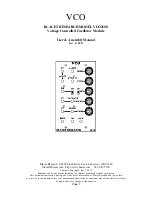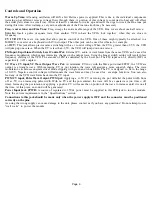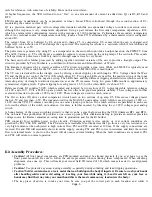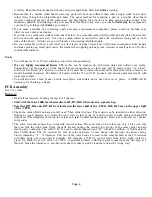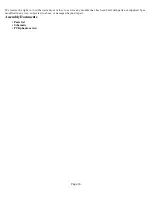
Page 6
correctly. Read thru this manual and check your parts against the Parts List
before
starting!
• Because this is a double sided board, removing parts will be more difficult than with a single sided board since
solder flows through the plated through holes. The usual method for replacing a part on a double sided board
involves cutting all the legs of the component and desoldering the pins one at a time, using a solder sucker. This
minimizes possible board damage due to excess heat. Needless to say, since you will be
destroying
the component,
you want to get things right
before
you solder!
• If you make a mistake or are missing a part and need a replacement component, please e-mail us. Include your
order invoice number and name.
• If you have not soldered a double sided board before, be aware that solder will flow through the plated board holes
and out onto the opposite pad. Use only as much solder as required to make the connection look good on both
sides of the board. A little care now will insure a long lasting reliable module.
• Do your assembly work on a soft towel or a few layers of paper towel. This will protect components from impact
and make picking up small parts easier. Be careful when opening part bags (use scissors) as small parts can fly off a
considerable distance!
Tools
• You will need a 15 to 25 watt soldering iron with a fine pointed tip.
• We very highly recommend Kester 331
as this can be cleaned up with warm water and solders very nicely.
Connections off the board or to the board that are inconvenient to clean may best be made with a “no clean”
solder such as Kester 245. Rosin core solder can be used but is really somewhat old fashioned and flux removal can
involve harmful chemicals. We build our boards with the 331 and 245 products and cannot guarantee results with
rosin core solders.
• You will also need a lead bender, needle nose pliers, side cutters, and a nut driver set or pliers. A DMM will be
necessary for checking voltages.
PCB Assembly
Use 331 solder.
Resistors:
• Insert all the resistors, bending the legs at 45 degrees.
• Start with the three 100K matched resistors, R8, R9, R10.
These are in a separate bag.
• Note that R57-R61 and R27, R28 are located on the lower half of the -2 PCB. R62, R63 are on the upper right
of the -3 PCB.
• Check the values. Did you have any left over? Then solder in place. The resistor can be inserted in either direction,
although a good practice is to orient the color code so that it can be read from left to right along with the PCB
silkscreen. This simplifies checking the values and later troubleshooting/repairs. Don’t get confused over similar
color codes.
• The color code chart shows how to identify resistor values. The exact hue of the colors can vary a bit, so be sure
that you pick the right value. Using the parts list and putting the resistors into groups of the same value can help
clear up any confusion. The suffix “K” is used to denote thousand and “M” stands for million. A 56K resistor is
thus 56,000 ohms. The 1% resistors are blue in color and have 5 color bands, with the right one always being
brown, indicating “1” % tolerance. The rest of the color bands are read in the same fashion as the 5% resistors
with there being one more digit to consider. For example, a 75K 1% resistor reads from left to right: violet (7),
green (5), black (0), red (2 zeros) or 75000. A possible problem with this system comes when the first digit is 1
(brown). Since the tolerance is also brown, make sure that you don’t read the resistor the wrong way!

